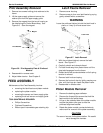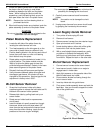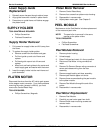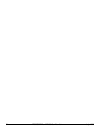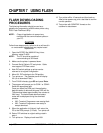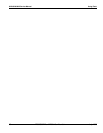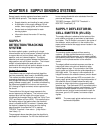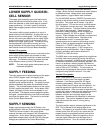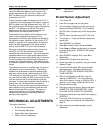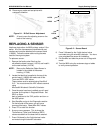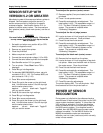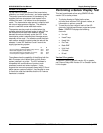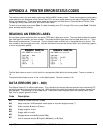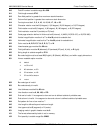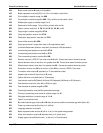
9820/9830/9835 Service Manual Supply Sensing Systems
TC9830SM Rev. B 7/98 Confidential July 199838
LOWER SUPPLY GUIDE/BI-
CELL SENSOR
The supply guide assembly spans the feed module
frame just behind and below the platen roller. It sits
within two détentes on each frame edge to maintain
proper positioning. It is held in place by individual
plastic tabs engaging square holes on both sides of
the frame.
Two center-justifying supply guides sit on top of a
guide frame and are interlocked. A guide lock arm is
positioned on the outside guide. The Bi-Cell supply
sensor and housing are attached to the middle of the
supply guide frame so that it is lined-up with the IR
emitter in the upper supply guide. The sensor wiring
harness attaches to the sensor housing and runs
along the bottom of the guide frame and through the
feed module frame to the Control Board Assembly.
Version 5.2 or greater:
The center justified reflective sensor is mounted on the
lower supply guide support and provides an index
signal when using black mark butt cut labels and black
mark tags. The reflective sensor is surface mounted
to the reflective sensor junction PCB assembly.
NOTE: The new supply guide mechanisms are not
backward compatible.
SUPPLY FEEDING
The main components of supply feeding are the platen
roller, 25VDC stepper motor, and supply guide.
Supply guides are used to capture the supply and
maintain center-justified tracking. The supply must be
positioned between the platen and printhead to feed
properly. The printhead applies pressure to the supply
to hold it against the platen roller. As the platen roller
rotates, the supply is forced to move between it and
the printhead. The stepper motor engages the platen
drive gear (located behind the inner feed module wall)
and drives the platen roller. The function is controlled
by the Control Board Assembly.
SUPPLY SENSING
Supply sensing begins when the IR Emitter in the
supply deflector, emits an IR beam through the supply.
The Bi-Cell sensor located in the supply guide,
receives the beam and changes it into corresponding
voltage level. As the beam intensity changes, the
associated voltage output of the Bi-Cell also changes.
Voltages are reported to the Control Board Assy.
where they are compared to a known base-line
voltage. When the input characteristics match (relative
to predefined times, voltage levels, and expected
supply position), a gap or black mark is sensed.
For the 9820/9830 printers, SENDFILE provides volts
relating to the sensor’s activity as stock moves past
the sensor. Two points are of interest: high point
(must be approx. 176) and low count (must be approx.
79). Two sensor channels are used. One measures
the paper’s presence. The other detects the transition
from stock to gap and back. These transitions
produce an analog waveform which changes from
reference (typically -2.5 VDC or approx. 128 A/D
counts). These voltages are continually monitored and
adjusted by the microprocessor. Because of this
microprocessor control, no meaningful static
measurements can be made to the sensing circuitry.
Paper to Gap is a negative waveform whose active
threshold is +1.75VDC or 89 A/D counts. The
waveform must drop approx. 10 A/D counts to be
acted upon as a valid transition. Gap to Paper is a
positive +waveform whose active threshold is
+3.25VDC or 166 A/D counts.
The 9835 uses a new sensing system that is optimized
for black mark sensing while still having the ability to
detect die cut supplies. All 9835 printers contain a set
of matched components that are factory adjusted. Our
intent is to produce a sensing system that does not
require physical alignment in the field. If a sensor fails,
order a Sensor Kit (11879801). The kit contains a
matched set of components that must be installed and
configured using Sendfile Version 2.14 or later.
Version 5.2 or greater:
When a label advance command is received the
software checks to see if the supply has been
calibrated. If not Resync resets the A/D signal
measuring parameters. When the supply starts
moving forward the A/D signal value is captured. It is
matched against the highest value saved and the
lowest value saved. If the new value is larger then the
current high value or lower than the current low value it
replaces that value. In this way the differential
between minimum and maximum signal can be
determined. Sometimes this differential is referred to
as the span. This cycle is repeated for each motor
step interval while the motor is running during
calibration.
The first transition edge of software significance is the
BOF. This is defined as the leading edge of the
feature. It is based on an algorithm that on every step
checks to see if the AD count is at a value that has
passed through a calculated threshold moving from
white into the feature. Before the algorithm can be
used the signal differential must be larger then a
predefined minimum. Once this criteria has been




